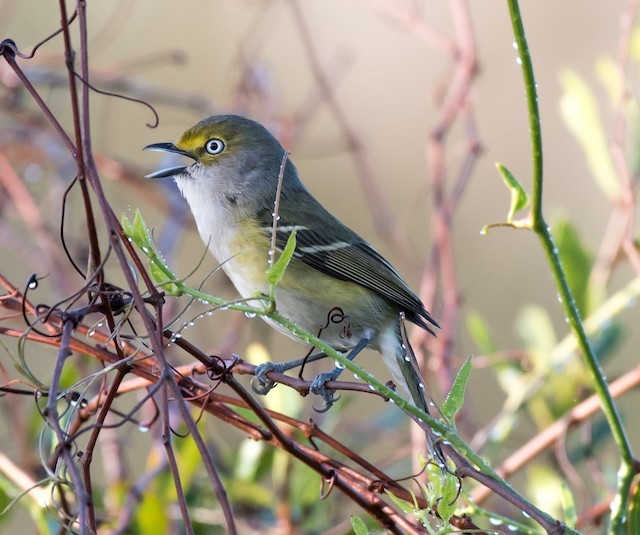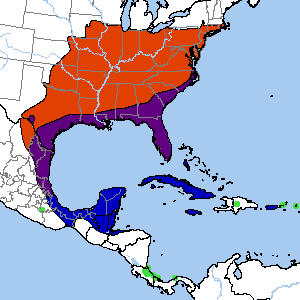Birdfinding.info ⇒ A common and widespread breeder across much of the eastern U.S. (see Breeding Bird Survey Abundance Map in Notes, below). Common year-round along the Gulf Coast and throughout Florida.
White-eyed Vireo
Vireo griseus
Breeds in eastern North America and winters from the southeastern U.S. southward into the West Indies and Central America. Also resident on Bermuda.
Breeding. Brushy woodlands, thickets, and scrub across most of the eastern U.S. north to Iowa, southern Michigan, and southern New England, and into Canada around Lake Erie, south to southern Florida, west to western Texas, and south on the Gulf slope of Mexico to northern Puebla and central Veracruz.
Nonbreeding. Winters on the coastal plain from North Carolina southward through Florida, Cuba, the Bahamas, and the Cayman Islands, and around the Gulf of Mexico to the Caribbean slope of Honduras. Rare or casual winter visitor east to Puerto Rico, west to California, and south to Panama.
Movements. From spring into fall, regularly strays west and north of its breeding grounds—as far as New Mexico, Colorado, Minnesota, Quebec, and Nova Scotia.
Identification
Adult is easily recognized by its unique combination of bold yellow “spectacles” and pearly white eyes. The upperparts are mostly olive, with contrasting gray on the head and neck, an olive mask and forecrown, and two white or yellowish wingbars. The underparts are whitish with a yellow wash on the sides.
The Mexican subspecies perquisitor (sometimes known as the “Veracruz Vireo”; see Notes, below) has more uniformly olive upperparts and uniformly dull yellowish underparts.

White-eyed Vireo. (Tifft Nature Preserve, Buffalo, New York; November 26, 2015.) © Sue Barth
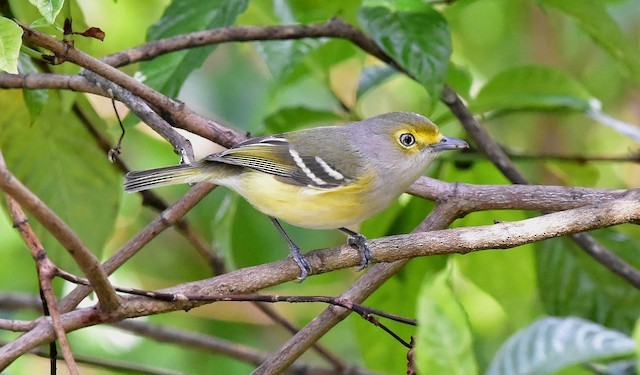
White-eyed Vireo. (Largo Central Park Nature Preserve, Largo, Florida; January 25, 2018.) © JoAnna Clayton

White-eyed Vireo. (Big Cypress National Preserve, Florida; October 27, 2017.) © David True

White-eyed Vireo. (South Padre Island, Texas; April 8, 2018.) © Ann Vaughan
Immature White-eyed Vireos have dark eyes and are potentially confused with certain other vireos (cf. Thick-billed Vireo, below). They have the same overall coloration and pattern as adults, but their colors and often muted, duller than on adults.

White-eyed Vireo, immature. (Queen Anne’s County, Maryland; September 30, 2017.) © Daniel Irons

White-eyed Vireo, juvenile in fresh first plumage. (Colt State Park, Bristol, Rhode Island; August 6, 2017.) © Evan Lipton
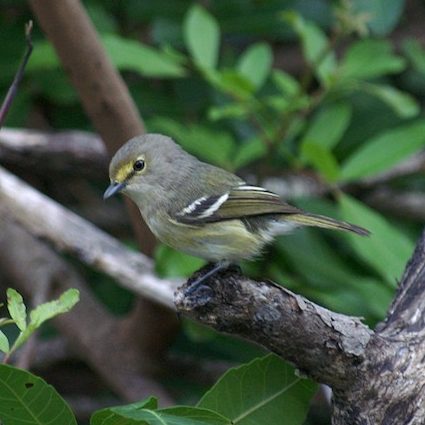
White-eyed Vireo, V. g. bermudianus, immature. (Happy Talk Drive, Bermuda; November 18, 2006.) © W. Derek Gibbons

White-eyed Vireo. (Playa Giron Caleta Buena, Matanzas, Cuba; January 15, 2016.) © Michael J. Good
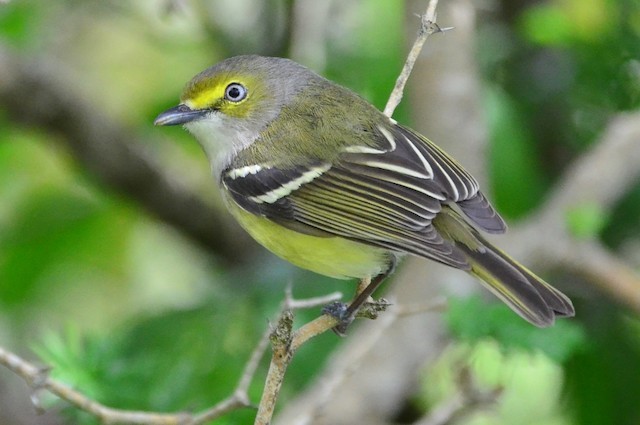
White-eyed Vireo, an unusually lemon-yellow individual. (South Padre Island, Texas; March 29, 2014.) © Steve Tucker

White-eyed Vireo. (Crescent Bend Nature Park, Cibolo, Texas; March 24, 2018.) © Mike Stewart

White-eyed Vireo. (South Padre Island, Texas; April 8, 2018.) © Ann Vaughan

White-eyed Vireo. (Brewster Wing Island, Barnstable, Massachusetts; November 7, 2017.) © Susan Finnegan
The endemic Bermudan subspecies, bermudianus (pictured below), is not readily distinguishable from the widespread continental subspecies.

White-eyed Vireo, V. g. bermudianus. (Ferry Point Park, Bermuda; September 16, 2017.) © Paul Watson

White-eyed Vireo, V. g. bermudianus, with leg bands from research on this localized endemic subspecies. (ABS Reserve, Bermuda; November 15, 2017.) © Jay Gilliam
Voice. Song is an explosive chatter that most typically begins with two clearly voiced notes, the strongest emphasis on the second note, which is upslurred: There are many variants, some placing the emphatic upslurred note later in the sequence: Other variants could be described as chaotic chattering:
Cf. Thick-billed Vireo. Immature White-eyed Vireo has a dark eye and is easily confused with Thick-billed Vireo in the Caribbean region. Their overall plumage patterns are similar, including their facial markings, as both have thick yellow supraloral bars and thin eyerings. Thick-billed’s eyering is often white but it can also be yellow, as on White-eyed.
The key difference is that White-eyed has complete, or nearly complete, yellow “spectacles” (referring to the eyering and supraloral bar) whereas Thick-billed’s eyering has a distinct gap above the eye.
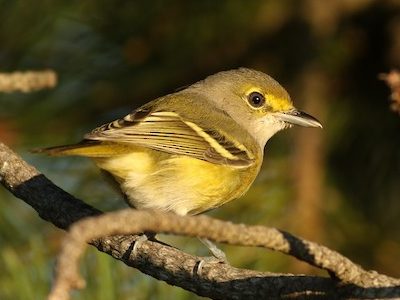
White-eyed Vireo, immature with partly broken eyering. (Prudence Island, Newport, Rhode Island; September 9, 2017.) © Jonathan Eckerson
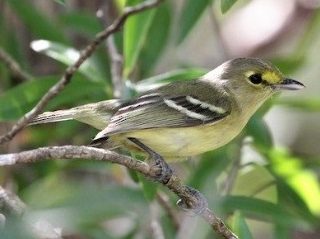
Thick-billed Vireo, showing the diagnostic gap in the eyering above the eye and black loral line. (Botanic Park, Grand Cayman; March 3, 2018.) © Charles Davies
Confusingly, however, some immature White-eyed Vireos also show a broken eyering, but rarely if ever with a gap as pronounced as the one on Thick-billed. (See photo comparison, above.) In addition to the gap in its eyering, Thick-billed typically has a well-defined blackish line on its lore, which frames and enhances the prominence of the yellow supraloral bar.
Thick-billed’s overall coloration is variable, so most details of color and pattern are unreliable field marks. Thick-billed is usually more evenly colored both above and below, lacking White-eyed’s sharp contrasts—in particular, the contrasts between its gray nape and olive back and between its yellow flanks and white belly.
Notes
Polytypic species consisting of seven recognized subspecies.
“Veracruz Vireo.” The southernmost Mexican breeding population, V. g. perquisitor, of northern Puebla and central Veracruz, has been suggested as a candidate for recognition as a separate species, the “Veracruz Vireo,” but there appears to be no clear indication of reproductive isolation or significant divergence from other populations of White-eyed Vireo.
References
Alderfer, J., and J.L. Dunn. 2014. National Geographic Complete Birds of North America (Second Edition). National Geographic Society, Washington, D.C.
Brewer, D. 2018. White-eyed Vireo (Vireo griseus). In Handbook of the Birds of the World Alive (J. del Hoyo, A. Elliott, J. Sargatal, D.A. Christie and E. de Juana, eds.). Lynx Edicions, Barcelona. https://www.hbw.com/node/61241. (Accessed November 16, 2018.)
eBird. 2018. eBird: An online database of bird distribution and abundance. Cornell Lab of Ornithology, Ithaca, N.Y. http://www.ebird.org. (Accessed November 16, 2018.)
Fagan, J., and O. Komar. 2016. Peterson Field Guide to the Birds of Northern Central America. Houghton Mifflin Harcourt, New York.
Garrigues, R., and R. Dean. 2014. The Birds of Costa Rica: A Field Guide (Second Edition). Cornell University Press, Ithaca, N.Y.
Garrido, O.H, and A. Kirkconnell. 2000. Field Guide to the Birds of Cuba. Cornell University Press, Ithaca, N.Y.
Haynes-Sutton, A., A. Downer, R. Sutton, and Y.-J. Rey-Millet. 2009. A Photographic Guide to the Birds of Jamaica. Princeton University Press, Princeton, N.J.
Howell, S.N.G., and S. Webb. 1995. A Guide to the Birds of Mexico and Northern Central America. Oxford University Press, Oxford.
Raffaele, H., J. Wiley, O. Garrido, A. Keith, and J. Raffaele. 1998. A Guide to the Birds of the West Indies. Princeton University Press, Princeton, N.J.
Ridgely, R.S., and J.A. Gwynne. 1989. A Guide to the Birds of Panama (Second Edition). Princeton University Press, Princeton, N.J.
